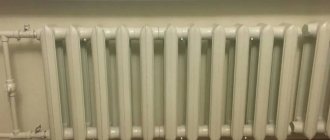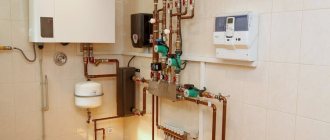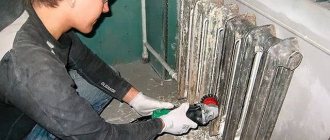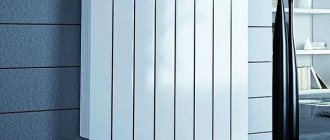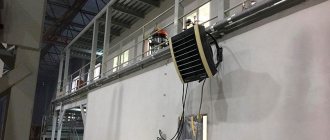Not so long ago, another line appeared in the bills of Russian citizens - “DHW heating”. This is a separate service that must be paid every month. Lack of payments leads to huge debts, fines, and court proceedings. Such payment is established by law, but payers often do not understand what it means. Therefore, consumers should understand the essence of such indicators and learn to calculate them themselves. It is also important to know how and where to file a complaint if you receive incorrect charges.
The use of a centralized hot water supply system requires payment for the supplied water in the form of a two-part tariff Source sovkusom.ru
Law on hot water supply
In 2013, Government Decree No. 406 was issued. According to the latter, users of a centralized heating system are required to pay for hot water supply at a 2-component tariff: for cold water, heat energy. Then the line “DHW heating” appeared on the receipt.
As you know, heated towel rails and risers connected to the circuit emit heat, which is used for additional heating of the room. Previously, it was not taken into account in receipts; it was used free of charge by consumers, since after the end of the heating season, the heating of the air in the bathroom did not stop. Therefore, housing and communal services specialists divided the tariff into two articles, and citizens are obliged to pay for them.
In 2013, Decree of the Government of the Russian Federation No. 406 was adopted, on the basis of which all users of the centralized heating system are charged a two-part tariff Source pokrovsk-rielt64.ru
The “DHW” column (coolant component) indicates the charge for hot water that passed through the flow meter over a monthly period. If the meter does not function or is not present in the apartment, the average or standard value calculated for all registered users in the home is taken as the basis.
The line “DHW heating” shows how much energy is spent on bringing the water supplied to the apartment to the desired temperature. Indications about the use of such heat energy are read from a flow meter common to the entire house.
Some payers doubt the legality of a two-component tariff and the inclusion of an additional line in the payment order. It is worth noting that such a judgment by residents is not at all justified; it leads to the accumulation of huge debts, which will still have to be paid later.
The column “DHW heating” indicates the amount of heat energy spent on heating the water supplied to the apartment to the required temperature Source img.znak.com
Dependence of the system on the heat source
The system can be classified according to a variety of criteria. If we consider them on a large scale, we can distinguish several options:
- Centralized are associated with the installation of a boiler room. It heats the medium, which is supplied to several multi-storey buildings at the same time.
- Locals are required to service only one structure. They are characterized by low power, since they are designed to heat a small volume of medium.
In industrial buildings, a system can often be installed that involves the use of secondary steam to heat the premises. This option reduces costs because thermal energy is reused.
Thermal energy component
It is impossible to find out the amount of heat energy spent using a measuring device. During its calculation, the following data is taken into account:
- tariff applied to DHW;
- calculation of heat loss;
- funds spent on maintaining the trunk system;
- transportation costs.
The service is usually calculated taking into account the current readings of the general house flow meter. In addition, the energy of the heated water is taken into account. This indicator is calculated individually for each apartment.
Which radiators are suitable for heating networks?
Any heating devices can be installed on a closed heating system: cast iron, steel, aluminum, copper, bimetallic. When installed correctly, high-quality radiators will last a long time. For example, IRSAP Tesi radiators have a proprietary leakage guarantee of 20 years.
How to calculate it yourself
It is not difficult to verify the accuracy of the amounts accrued in the payment order. To do this, you should find out in advance the price of thermal energy in the current period. The final result of the calculation is also affected by the presence or absence of a water meter. If the latter is installed in an apartment, its readings must be taken into account. Otherwise, the established standard is taken into account. It is approved by the energy supply company and represents the average rate of heat energy consumption required to heat a unit volume of water.
When the house has a general energy flow meter and a water meter in the house, the amount for heating the hot water supply is calculated based on their indicators. In the absence of a common house meter, the calculation is made based on the accepted rate of energy consumption (indicated per 1 m3) and the readings of an individual water meter.
A general house flow meter is installed on a branch of the heating system and shows the amount of thermal energy consumed in Gcal Source terman-s.ru
Formula for calculating the amount of payment for hot water supply:
S = Vg.v. * Tx.v. + (Vt.en. * Vg.v. / ∑V g.v. * Tt.en.), where
Vg.v. – the volume of hot water used per month in a separate apartment;
Tx.v. – tariff cost of cold water;
Vt.en. – heat energy spent during the month to heat cold water;
Tt.en. – tariff set for thermal energy;
∑V g.v. – the volume of hot water used by all apartments in a residential building over a monthly period.
Using this formula, DHW is calculated for dwellings with an individual flow meter. If there is none, the calculation is carried out on the basis of the standard adopted in this region. This value is divided by the number of registered residents of the apartment. Moreover, the final result is approximate, which is due to the following nuances: payments also include expenses for repair work and maintenance of accounting equipment in houses.
You can calculate the amount of payment for hot water supply using a special formula Source heatylab.com
Example of calculation of payment for hot water supply
Monthly consumption of hot water by residents of one apartment is 6 m3, for the entire house - 470 m3. The amount of thermal energy spent on heating the hot water supply (according to the readings of the general house meter) is 34 Gcal. Then
S = 6 m3 * 33.3 rub. + (34 Gcal * 6 m3 / 470 m3 * 1331.1 rub.) = 199.8 + 577.8 = 777.6 rub. Of them:
- 199.8 rub. – payment for actual water consumption (DHW);
- 577.8 rub. – the cost of heat energy spent on heating water to a certain temperature (DHW heating).
In order not to overpay, it is recommended to check the amounts indicated in the payment receipt yourself Source novostipmr.com
Cold water supply
The cold water supply system is significantly different. Its features are as follows:
- Water is not heated.
- A separate highway is created for the system.
- Maintenance of the system is possible by installing several valves.
Due to the normal temperature of the water, it can be supplied under high pressure. This is due to the fact that heat affects important elements of the system.
How to file a complaint if a payment receipt was calculated incorrectly
Typically, housing and communal services settlement departments distribute the amounts spent on repairs of a common house water heating device among the residents registered in the house. At the same time, the presence of an autonomous system in some apartments is not always taken into account. As a result, their owners are required to pay for the maintenance of devices that they do not use at all.
Sometimes you receive receipts with increased tariffs. In such circumstances, you must contact the management company. It is recommended to visit its settlement branch or write a letter asking for clarification of the accrual of certain amounts. If there are no explanations, you must submit a claim to the Criminal Code or its legal department. A written response must be received within a month. If the management organization reveals the fact of an erroneous calculation, a recalculation must be carried out. Based on the latter, the user will receive compensation for the overpayment.
Advice! When management companies do not respond to a submitted claim for a long time, it is recommended to file a lawsuit. When writing a statement, it is important to describe in detail the essence of the violation and put forward your demands. When preparing a document, you must refer to current legislation.
The legality of charging utility bills for DHW heating can be challenged in the prosecutor's office. You can also contact the structures that control the work of the management company, write a complaint to the Ministry of Construction, Rospotrebnadzor, FAS, and housing inspections.
If, after independently calculating the amount of contributions for hot water supply, a difference is identified, and the organization’s employees refuse to give explanations about this, you must submit a written claim to the Criminal Code Source iurist.info
Pipes
What pipes can be used for heating and hot water?
Let's separate the flies from the cutlets, so to speak: centralized (with elevator units) and autonomous engineering systems put forward completely different requirements for materials.
For central heating, the normal temperature is up to +95°C at a pressure of 4-5 atmospheres, which is already close to the limits of the capabilities of polymer materials. At DHW the standard temperature is lower (75°C), but the pressure is higher (up to 6 kgf/cm2). The picture is aggravated by the high probability of deviations from standard values and the occurrence of water hammer.
Pipe rupture due to water hammer
In autonomous heating systems, pressure is maintained up to 2.5 kgf/cm2 at temperatures up to 75-80°C, in autonomous hot water supply - up to 4.5 kgf/cm2 at 60-75°C. The parameters are stable, water hammers are excluded (more precisely, they can only be created by the owner of the house, which is not in his interests).
From this video you will learn about pipes for heating and water supply.
For central hot water supply and heating the following are used:
| Image | Description |
| Galvanized (steel pipe with zinc coating). Unlike black steel, it does not become overgrown with deposits and is not subject to corrosion. Mounted only on threads: welding damages the anti-corrosion coating. |
| Copper pipe. It is mounted on soldered socket joints, on press and crimp fittings. Tensile strength exceeds 200 atmospheres, heat resistance reaches 150-250 degrees, depending on the type of fittings used. |
| Stainless steel corrugated pipe. With characteristics close to copper, it is 2-3 times cheaper, and much easier to install: the connection on the compression fitting is assembled with two adjustable wrenches in 30 seconds. |
For autonomous engineering systems the following can be used:
| Image | Description |
| Polypropylene pipes (usually with a reinforcing layer - foil or polymer mixed with fiber). Their advantages are the low cost of the pipes and fittings themselves for low-temperature welding. |
| Heat-resistant and cross-linked polyethylene (PERT and PEX) are ideal pipes for heating and water supply in the floor when manifold wiring systems: they are sold in coils up to 200 meters long, which allows you to extend all connections beyond the screed (see Polyethylene pipes for water supply). |
| Metal-polymer pipes (on crimp and press fittings) are also sold in coils and are equipped with an aluminum welded core glued between two layers of PERT or PEX. Their advantages are wall rigidity and relatively high tensile strength (up to 16 kgf/cm2). |
Two-pipe heating
A two-pipe heating system requires connecting each radiator to pipelines that are responsible for the flow of heated coolant and the removal of coolant. The main positive aspect of this design is the ability to adjust the temperature of individual heating elements.
Vertical scheme
When implementing such a project, several wiring options are provided:
- Lower two-pipe distribution - the main heating unit, which supplies coolant to the heating elements, is located in the basement or above the floor level of the lower floor. Riser pipes in a multi-storey building are diverted from the main pipe, the presence of which ensures the flow of working fluid to the radiators. Subsequently, the cooled liquid moves in the opposite direction through the outlet pipes.
- Upper two-pipe distribution - involves supplying coolant from the main heat generator directly to the attic of the house. Passing through the heating radiators, the heated working fluid returns from the upper distribution through the corresponding risers.
In order to remove air that accumulates during operation, it is recommended to supplement the two-pipe system with a special expansion tank. Installing the tank yourself allows you to ensure high pressure levels when moving coolant, which helps to increase heating efficiency.
Horizontal scheme
This option is the most common when installing two-pipe heating.
Functionality is ensured by forced circulation of coolant. There are the following options for implementing such a scheme:
- Dead end. It is characterized by relatively low consumption of materials when installing heating. The obvious negative point here is the impressive length of the system circuit, which is laid in a wide circle from the main heating unit. Compliance with such a requirement complicates the regulation of the temperature of individual heating elements.
- Along the way. Allows you to make correction of the coolant temperature in individual radiators more convenient due to the equal length of the circulation circuits. At the same time, the implementation of such a project requires the use of a significant number of pipes.
- Ray. It assumes radial distribution of the coolant, which is accompanied by maximum consumption of consumables. An obvious advantage is the possibility of hidden installation of the pipeline system in the thickness of concrete. This allows you to maintain the visual appeal of heated rooms.
Two-pipe heating system for a 2-story house
Truly comfortable living conditions can only be achieved by installing a two-pipe heating system. Its design allows you to regulate the temperature in individual rooms and save energy resources.
How does a two-way circuit work?
Unlike a single-pipe circuit, a two-pipe circuit consists of a pair of lines with different purposes: one of them supplies coolant, the second returns it back. The radiators are connected not in series order, but in parallel. One circuit, with heated coolant, extends from the riser to the radiators of both floors, the second is mounted to the boiler outlet and is also distributed to both floors.
Radiators are equipped with thermostatic valves that allow you to set a comfortable temperature. If desired, you can reduce the heating intensity partially or completely block the flow of water into the device.
Some devices are fundamentally embedded in the return line, for example, a membrane tank that regulates pressure, a circulation pump and a safety valve are traditionally installed in front of the boiler
In modern 2-story houses, two-pipe structures are used, since they are much more efficient than single-pipe ones:
- reduce pressure loss;
- do not require a powerful pump;
- keep the coolant temperature the same for each radiator;
- allow you to use many different thermal devices within one system (for example, radiators, convectors and “warm floors”);
- make it possible to repair and replace parts without compromising overall functionality.
The main disadvantage is the difficulty of self-installation - during assembly, consultation and supervision of professionals is required.
Successful solutions for installing a two-pipe system
There are many incarnations of various schemes, but when drawing up a project you should start from individual requirements.
The simplest diagram for arranging a heating system in a 2-story house. It is characterized by the following points: 2 circuits for heating and hot water production, liquid coolant, forced circulation (+)
A number of universal schemes are suitable for providing heat to houses of various sizes and number of floors.
Detailed diagram of two-pipe wiring for a one-story house with a fully equipped basement. The problem of thermal insulation of the floor in the basement was solved by connecting a water-based “warm floor” system
If you install additional equipment, such as a membrane tank, the capabilities of the heating system will expand.
A and B – two variants of the wiring device, upper and lower type. Additional equipment: expansion tank, Mayevsky taps, overhead line (+)
The following diagram combines the three most popular wiring diagrams.
Level 1 – dead-end wiring with parallel installation of both circuits; Level 2 – counter wiring, characterized by two-way radiator connection; 3 – collector wiring with improved balancing
All of the above schemes are suitable for heating a 2-story building.
Classification of boilers
According to the method of placement in the room:
- floor;
- mounted.
According to the method of removing combustion products:
- chimney (with natural draft and open combustion chamber);
— with a turbo hood (with a coaxial chimney and a closed combustion chamber);
- with semi-turbo prefix.
Depending on electricity:
— dependent (with forced circulation);
— independent (with the ability to work under natural circulation).
By boiler functionality:
— single-circuit (heating only);
— double-circuit (heating + hot water supply).
Boilers, depending on the type of fuel (energy), are divided into:
— gas;
— diesel;
- solid fuel;
- electric.
Solid fuel boilers of domestic production are currently practically not used, due to the low efficiency, the impossibility of automatically adjusting the boiler operating modes, and the impossibility of automatically supplying fuel to the combustion chamber. Imported samples of solid fuel boilers do not have these disadvantages, but require specially processed fuel (granulated or briquetted).
Electric boilers consist of:
— heat exchanger (thermal insulated container);
— heating element (tubular heating elements);
— automation that regulates the operating modes of the boiler.
Electric boilers of domestic production (Dnepropetrovsk) are produced with a power from 4 to 360 kW. Up to 6 kW at 220 V and 380 V, starting from 9 kW and above - only 380 V. Floor-standing boilers with a power of up to 15 kW can operate in natural circulation systems. All mounted ones require forced circulation.
Electric boilers Protherm (Czech Republic) have a power range from 9 to 24 kW, only at 380 V and only in a mounted version.
Complete with:
— circulation pump;
- membrane tank;
- boiler safety group.
Electric boilers are environmentally friendly, do not require a chimney, the efficiency of electric boilers is ≈ 98-99%.
Diesel boilers are used in non-gasified areas. They are convenient because their design allows you to change the burner and switch to gas. However, these boilers require bulky tanks for diesel fuel and a specially equipped room for installing these tanks. Diesel boilers are offered by Protherm (Czech Republic) with a capacity of 18 kW and above.
Gas boilers are most widespread due to their economy and efficiency. It is gas boilers that have the largest number of design options.
Water heating equipment
A water heater is installed in an apartment building. Failure of the device does not affect the tariff change. But the repair of a broken water heater is paid for by the residents of the house. The device is part of the common property. If it breaks down in the housing and communal services receipt, in the line “Repair of property” there will be a certain amount spent on fixing the problem.
Important! Residents of apartments equipped with an autonomous system do not have to pay for water heating. They do not use the central system and pay only for the amount of electricity or gas spent on heating the resource with a home boiler or boiler.
Possible problems
What problems may you encounter:
With instantaneous water heater
Each chosen method of providing a home with hot water has its own weaknesses.
Electric flow heaters often fail due to burnout of heating elements, which become covered with scale and cannot withstand the load.
The same applies to the heat exchanger - poor water quality clogs the coil or honeycomb, which leads to excess pressure, and possibly even rupture and leakage of the equipment.
Therefore, maintenance consists of organizing proper filtration of the hot water supply, replacing heating elements and ensuring correct connection from an electrical point of view.
High-power electrical appliances must be equipped with individual electrical protective equipment. As for geysers and boilers, they need periodic cleaning of excess combustion products.
With storage water heater
The main problems remain the same - the performance of the heating elements, the quality of the incoming water and electrical safety.
It is electrical safety that many users neglect, not realizing that this is not only protection against electric shock, but protection of the most expensive equipment.
All models of storage heating tanks are made of metal, which means that without proper grounding, they are subject to accelerated corrosion. If the tank leaks, then in most cases such equipment cannot be repaired
This is why it is so important to check the ground circuit
As for heating elements, in these models they are even more susceptible to burnout than in flow-through ones.
Everything you need to know about hot water is presented in this section of the site.




